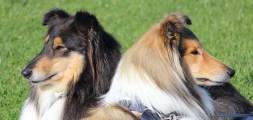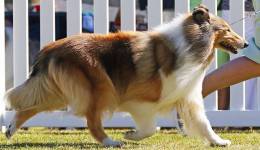Shetland Sheepdogs
 Shetland Sheepdog
Shetland Sheepdog
The Shetland Sheepdog is also among Scotland's oldest breeds. Their Spitz like characteristics make many respected dog historians believe they can be traced back directly to the ancient wolf that used to roam Britain. The Shetland Sheepdog is basically a miniature of the Collie (Rough).
History of the Shetland Sheepdog
 Sheltie pup Blue Merle
Sheltie pup Blue Merle
The Shetland Sheepdog originated in the Shetland Islands. Although these consist of around 100 individual islands, only around 15 are inhabited. Since Arctic civilizations began, these islands were continually visited by the peoples of the North. Historically part of Norway, today these islands are the northernmost point of Britain.
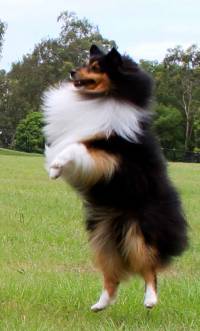 Sheltie (Tricolour)
Sheltie (Tricolour)
The early Herding dogs that existed in Scotland from 2,500 BC, would have almost certainly existed also in the Shetland Islands. Some of the bleak land on the inhabited islands became divided into small farms and tiny hamlets. But the desolate conditions were responsible for not only their horses to become miniaturized into their famous Shetland ponies, but also their sheep and cattle dog became miniaturized into the Shetland Sheepdog.
The Shetland Sheepdog becomes a Pure Breed
In 1908 the Shetland Collie Club was first formed within the Shetland Islands and a Breed Standard written. In opposition, a Scottish Shetland Sheepdog Club was formed on the mainland which produced its own Stud Book and Breed Standard at the same time as the Collie (Rough). After some argument about the height as well as the name, the Kennel Club (UK) bowed to the objections of local Collie breeders refusing the name 'Shetland Collie' and granting recognition conditional on the breed being called the 'Shetland Sheepdog'. After many further arguments, it was not until 1948 that the present height of 14" (inches) was agreed upon[1].
History of Shetland Sheepdogs in Australia
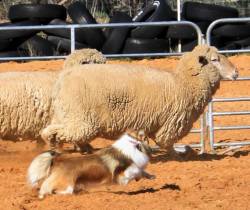 Shetland Sheepdog Herding
Shetland Sheepdog Herding
In the 1940's, 3 Shelties arrived from overseas followed by another 16 in the 1950's plus 16 more in the 1960's. Many well-known breeders who continued their Sheltie passion for decades, made their start in the 1950's and 1960's. Today they have plenty of bloodlines to work with the Shetland Sheepdog Club of NSW now recording over 200 imports from all over the world[4].
 Sheltie competing in Obedience
Sheltie competing in Obedience
Temperament has always been a significant factor with 2 Shelties taking out the award of 'highest score in Obedience Trial' at Melbourne Royal in 1989 and 1990, when it was Australia's largest dog show[3]. But most importantly, the Shetland Sheepdog has retained his instinct to herd sheep, the job he was bred to do hundreds of years ago in the bleak, cold terrain of the Shetland Islands.Despite Australia's harsh climate and terrain, the Sheltie pictured on the left above is happily competing in an Herding Trial in Queensland.
Meanwhile the Shelitie below on the right is competed in the Obedience at the Royal Melbourne Show 1990 in Victoria where there was almost 200 entries[3].
Comparison between the Collie (Rough and Smooth) and the Shetland Sheepdog
As the Collie (Rough and Smooth) are the same breed with the same Breed Standard, they are considered below in the same column, together with a comparison with their miniature 'cousin', the Shetland Sheepdog.
| Collie (Rough and Smooth) | Shetland Sheepdog | |
|---|---|---|
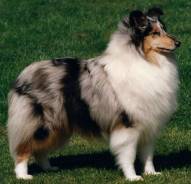 Collie (Rough) Blue Merle Collie (Rough) Blue Merle |
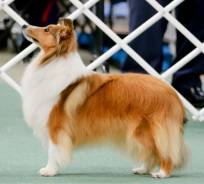 Sheltie (Sable) Sheltie (Sable) |
|
| Size | The Collie stands 56-61 cm (22-24 ins) at the shoulder for dogs and weighs 20.5-29.5 kg (45-65 lbs), and 51-56 cm (20-22 ins) at the shoulder for bitches and weighs 18-25 kg (40-55 lbs). | The Shetland Sheepdog ideally stands 37 cms (14½ ins) at the shoulder for dogs and 35.5 cms (14 ins) for bitches. |
| Colour | The three recognised colours are sable and white, tricolour and blue merle. There may be typical white Collie markings, like a full or part collar, white shirt, legs, feet, tail tip and a blaze on the muzzle, skull or both. | Black and white and black and tan without white markings are recognized colours. In addition, the Sheltie comes in sable, tricolour and blue merle, with or without white markings as a collar, on the chest, frill, legs and the tip of the tail but their absence should not be penalised. However, patches of white on body are highly undesirable. |
| General Appearance | A dog of great beauty, standing with an impassive dignity, its physical structure should be that of strength and activity, but never coarse or cloddy. | A small, long haired, working dog of great beauty, with a symmetrical outline, but never coarse or cloddy. |
|
|
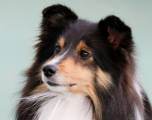 Sheltie Tri Sheltie Tri |
|
| Head Shape | The overall head shape should be that of a well-blunted, clean wedge, being smooth in outline whether viewed from the front or from the side. | Whether viewed from the top or from the side, the overall head shape should be refined and elegant with no exaggerations and resemble a long, blunt wedge, tapering from ear to nose. |
| Skull |
The skull should be flat. The sides of the head taper gradually and smoothly from the ears to the end of the black nose, without prominent cheek bones. |
The skull should be flat, moderately wide between ears, with no prominence of occipital bone. |
| Stop | A perceptible stop between parallel head planes | A slight but definite stop between parallel head planes |
| Foreface | The well rounded muzzle is blunt, but not square. The underjaw is strong, clean cut but not excessively deep. The nose must be black. |
The muzzle is well rounded and of equal length to the skull. The nose, lips and eye rims must be black. |
| Mouth | Normal scissors bite with teeth of a good size | Normal scissors bite with a full complement of 42 sound, strong teeth highly desired. |
 Collie (Smooth) Collie (Smooth) |
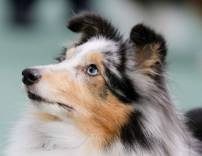 Sheltie Blue Merle Sheltie Blue Merle |
|
| Eyes | Responsible for the Collie's sweet expression, the medium sized eyes should be almond shaped and set somewhat obliquely. They should be dark brown except in blue merles when one or both eyes are blue or blue flecked. | The medium sized eyes are obliquely set and almond in shape. They should be dark brown except for merles, where one or both eyes may be blue or blue flecked as shown above. |
| Ears | The small ears should be neither close together on top of the skull, nor on the side of the head. When in repose they may be carried thrown back. But when alert they are brought forward and carried semi-erect, with the ratios shown as graphics. | The ears are small, moderately wide at base, and placed fairly close together on top of skull. In repose, they may be thrown back but when alert they are brought forward and carried semi-erect with tips falling forward. |
| Neck | The neck should be of fair length, muscular and well arched. | The neck should be of sufficient length to carry the head proudly, and well arched. |
| Forequarters | The shoulders should be well angulated. The forelegs should be straight and muscular with a moderate amount of bone. | The well laid shoulder blades should be equal in length to the upper arm. The elbow should be halfway between the ground and the withers. The forelegs should be straight when viewed from front, with strong, but not heavy, bone. Pasterns must be strong but flexible. |
| Feet | Oval in shape with the soles well padded and the toes arched and close together. | Oval in shape with the soles well padded and the toes arched and close together. |
|
|
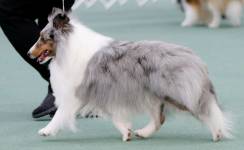 Sheltie Blue Merle Sheltie Blue Merle |
|
| Body |
The body should be a trifle longer than square, the back is firm with a slight rise over the loins. |
The body should be slightly longer than height at withers.The chest is deep, reaching the elbow. The back is level, with graceful sweep over loins to the rear. |
| Hindquarters | The muscular hind legs should be clean and sinewy, with well bent stifles and short hocks. | The thighs should be broad and muscular, the stifle is well bent and the hocks straight when viewed from behind. |
| Tail | The tail should reach at least to the hock joint and carried low when the dog is quiet. The tip has a slight upward swirl but may be carried gaily when the dog is excited, but never over the back. Hair on the tail very profuse. | The tapering low set tail should reach at least to the hock and has a slight upward sweep. It should be well covered with hair and may be slightly raised when moving. |
| Gait | Although moving with its front feet comparatively close together, plaiting or crossing are highly undesirable. From behind, the hocks should be parallel, making the the hind legs look powerful with balanced reach and drive. From the side the action is smooth, with a reasonably long, light and effortless stride. | The Sheltie moves has a lithe, smooth and graceful gait, moving with drive from hindquarters. Pacing, plaiting, rolling or stiff, stilted, up and down movement is highly undesirable. |
| Coat |
Collie (Rough) - the coat should fit the outline of the dog and be very dense. The double coat is straight and harsh while the undercoat is soft, furry and very close. The mane and frill should be very abundant, as are the hind legs above the hocks. Collie (Smooth) - the coat is also a double coat consisting of a short, flat top coat of harsh texture, and a very dense undercoat. |
The double coat is long, harsh textured and straight while the undercoat is soft, short and close. The mane and frill should be very abundant but the coat should fit the body and not dominate or detract from the outline of the dog. Smooth coated Shelties occur but are highly undesirable. |
References and Further Reading
[1] Margaret Osborne, 'The Shetland Sheepdog' Published by Popular Dogs Publishing Co. Ltd 3 Fitzroy Square London W1 Fifth Edition 1973, Chapter 1 'Origin and History of the Breed Pages 5 - 19.
[3] The Melbourne Royal Show Catalogue 1989, Published by RASV Limited, a Company Incorporated by the Royal Agricultural Society of Victoria, Ascot Vale Pages 186 -191.
[4] http://webs.dogs.net.au/sscofnsw/uploads/documents/Overseas_Imports_to_Aust__and__NZ.pdf
